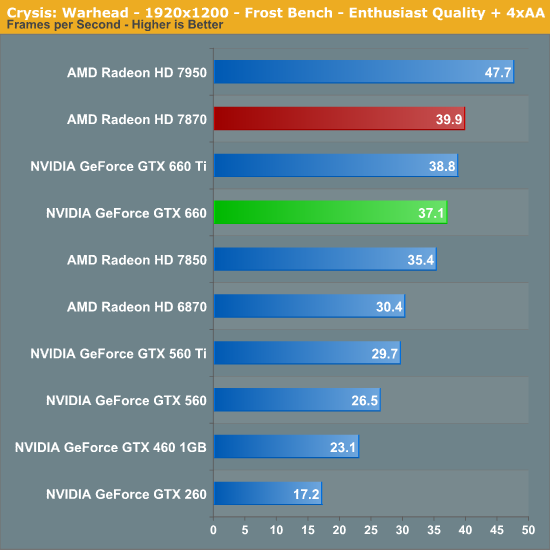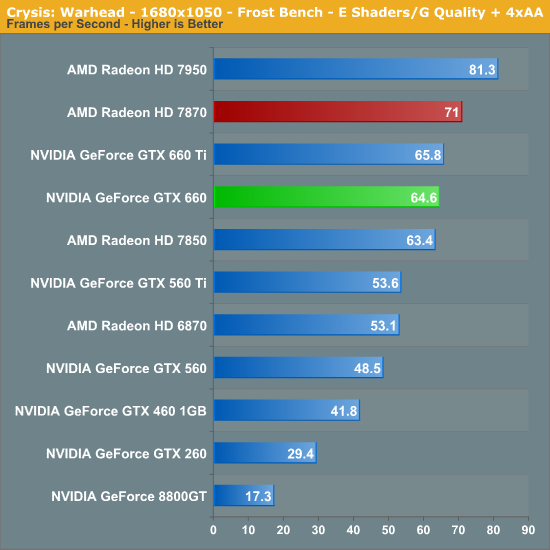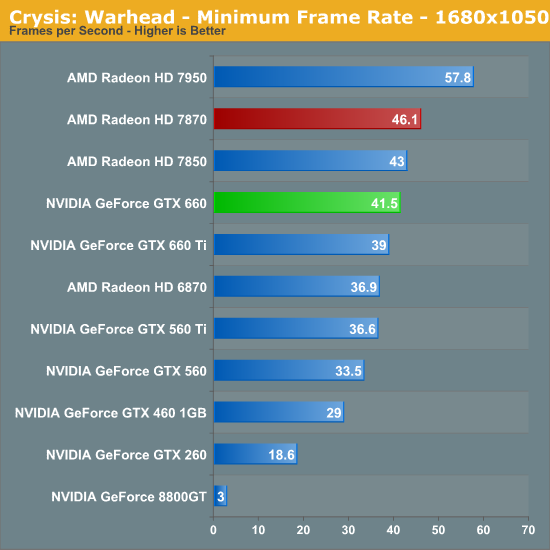The NVIDIA GeForce GTX 660 Review: GK106 Fills Out The Kepler Family
by Ryan Smith on September 13, 2012 9:00 AM ESTCrysis: Warhead
Kicking things off as always is Crysis: Warhead. It’s no longer the toughest game in our benchmark suite, but it’s still a technically complex game that has proven to be a very consistent benchmark. Thus even four years since the release of the original Crysis, “but can it run Crysis?” is still an important question, and the answer continues to be “no.” While we’re closer than ever, full Enthusiast settings at a 60fps is still beyond the grasp of a single-GPU card.


Crysis has been a game that has consistently penalized Kepler for its lack of memory bandwidth. Nowhere was this more evident than the GTX 660 Ti, which thanks to its memory bus reduction took a significant hit. But as we alluded to in our introduction, there’s a corner case where the GTX 660 is going to be able to easily keep up with the GTX 660 Ti: ROP and memory bandwidth-bound situations. As a result we’re looking at the best case scenario for the GTX 660 when held up against the GTX 660 Ti, which sees the GTX 660 offer 95% of the performance of the GTX 660 Ti. Most games aren’t going to be like this, but in this one case the GTX 660 may as well be as good as the GTX 660 Ti as far as performance goes, which goes to prove just how bottlenecked Crysis is by memory bandwidth.
Looking at a more meaningful comparison, because the GTX 660 doesn’t take a memory bandwidth hit compared to the GTX 660 Ti, the resulting card is much more resource balanced which in turn impacts AMD’s ability to lead in this benchmark. AMD once again wins here with the 7870 taking the lead, but only by a relatively modest 7% margin. This is the first time we haven’t seen a comparable AMD card lead by a significant margin in this generation, which for NVIDIA is an improvement though still not a reversal of fortunes. At the same time however NVIDIA isn’t doing too much better than the 7850 here, beating AMD’s lesser 7800 by an even more modest 5%.
As for NVIDIA’s older cards, the generational performance gains are in-line with what we’ve already seen out of the other GTX 600 cards. Compared to the GTX 460 1GB for example, a card that launched over 2 years ago at the same price, performance is up by 50-60%. But unsurprisingly this is less than the performance gain going from the 8800GT to the GTX 460, a similar timeline jump that saw performance more than double. At the very least NVIDIA certainly has the 8800GT licked at this point (by nearly a factor of 4x), but this means they’re also at risk of perpetuating longer upgrade cycles for current GTX 460 owners.


Moving on to minimum framerates, our results are almost the same with one interesting twist: the GTX 660 is now beating the more expensive GTX 660 Ti. Why? As we mentioned earlier, because of the higher core clock the ROPs on the GTX 660 actually have a greater theoretical throughput than the ROPs on the GTX 660 Ti. Since we’re not seeing any other factors that would explain this difference (i.e. drivers) it’s very likely that the GTX 660’s faster ROPs are giving it the advantage here.
Though while this is enough to push the GTX 660 ahead of the GTX 660 Ti, it’s not improving the GTX 660’s situation relative to the 7800 series at all. The GTX 660 is still closer to the 7850 than it is the 7870 here.










147 Comments
View All Comments
yeeeeman - Saturday, September 15, 2012 - link
Really, G80 was a revolution on its own. Spectacular jump in performance compared to the previous generation, and combined with 65nm process technology gave birth to some of the finest video cards.The real setback here, is the fact that the gaming industry is driven by the lowest common denominator, and we all know that consoles are the most important. They are sold in the largest quantities, and most games are designed for their power, not higher.
For PCs, games receive a DX11 treatment, with some fancy features, than enhance the quality a little bit, but it can never make up for the fact that the textures and the game is designed for a much slower platform.
So given these facts, why change my 9600GT, when it can handle pretty much everything?
steelnewfie - Saturday, September 15, 2012 - link
"For the 2GB GTX 660, NVIDIA has outfit the card with 8 2Gb memory modules"Should read outfitted.
Also 8 2Gb memory modules? Did you mean 2GB? Either is incorrect by my math.
If there are 8 banks should not each module be 256 MB?
Otherwise, great articles, keep up the good work!
Ryan Smith - Saturday, September 15, 2012 - link
Individual memory modules are labeled by their capacity in bits, not bytes. So each module is 2 gigabits (Gb), which is 256MB. 8x2Gb is how the card ends up with 2 gigabytes (GB) of RAM.MrBubbles - Saturday, September 15, 2012 - link
Cool, I have a GTX 260 and since NVidia is deliberately breaking their driver support for games like Civ 5 I guess this is the card to get.saturn85 - Saturday, September 15, 2012 - link
nice folding@home benchmark.JWill97 - Thursday, September 27, 2012 - link
For me, I really think it's the best card you can buy at this price. Not a fan (neutral) of both NVidia or AMD, but really, at $200+ segment nvidia takes it. But I still wondering, why all reviewers aren't using Maxpayne3 as one of the game benchmark? A lot of cards would be struggle playing it.Grawbad - Friday, March 1, 2013 - link
"NVIDIA has spent a lot of time in the past couple of years worrying about the 8800GT/9800GT in particular. “The only card that matters” was a massive hit for the company straight up through 2010, which has made it difficult to get users to upgrade even 4 years later."I am one of those. I purchased a 9800 GTX and that sucker runs everything. Mind you, all my other components were quality too so I didn't bottleneck myself. But this card has run everything I have ever thrown at it.. Only recently have I had to start watching the AA a bit. Which is why I am now, 5 years later in the market for a new card. 5 Years.
Indeed, those cards were astounding.
Mine was an EVGA 9800 GTX with a lifetime warranty. Thank goodness for that as it finally went out on me this year and I had to RMA it. And now that I am looking into getting a new card it seems EVGA has dropped their lifetime warranty. That makes me sad.
Anyways, yeah, those were are are still great cards. I mean, if you picked up a 9800 GTX today, you will be able to run even the newest games. Albeit youll need to turn down aa and such, but you can still get GREAT graphics out of most anything even today.